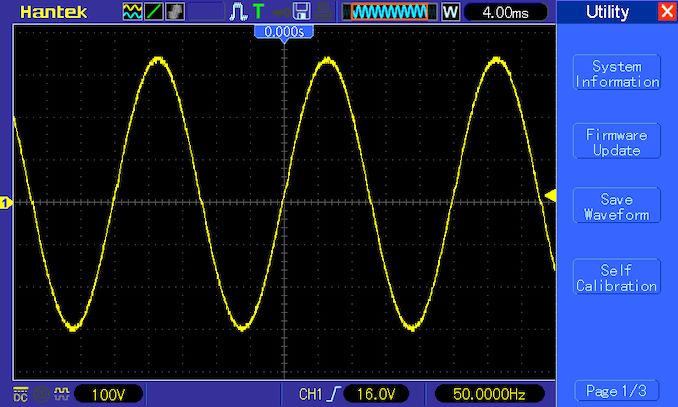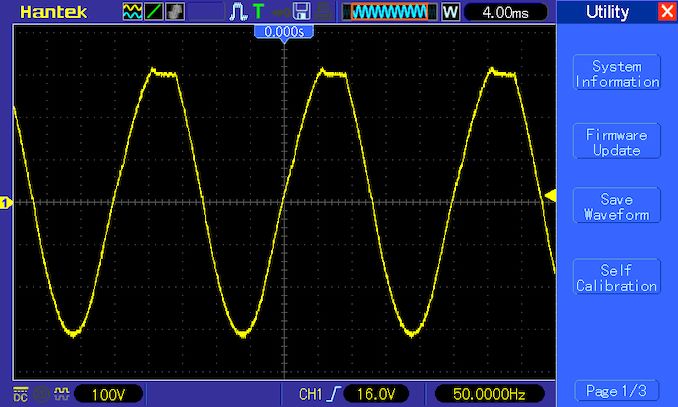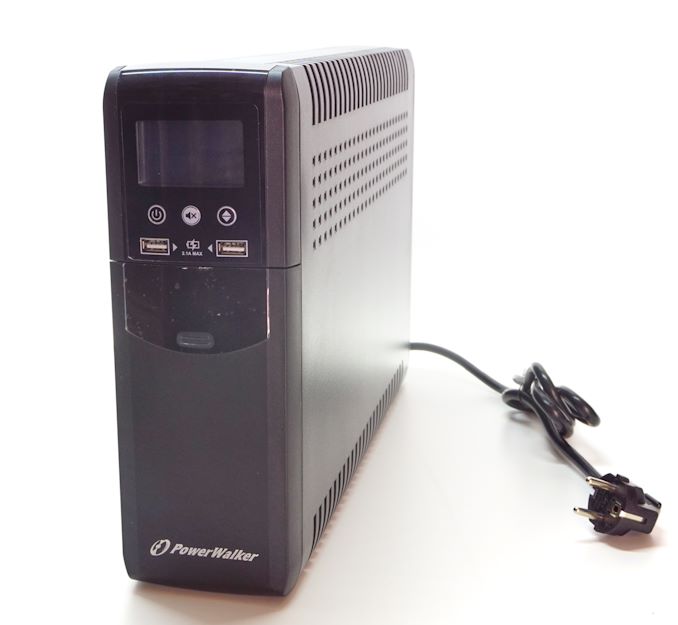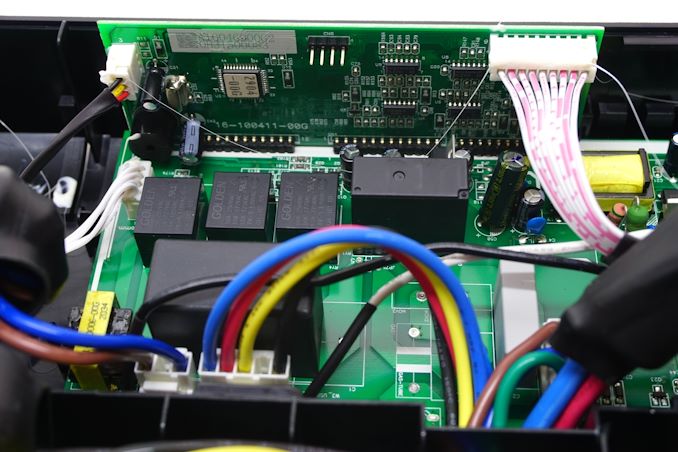The PowerWalker VI 1500 CSW UPS Review: Trying For True Sinewave on a Budget
by E. Fylladitakis on April 13, 2022 8:00 AM EST- Posted in
- Cases/Cooling/PSUs
- UPS
- PowerWalker
- BlueWalker
- 1500VA
Testing
Putting the PowerWalker VI 1500 CSW to the test, the basic electrical figures of the UPS are acceptable, with the unit delivering the performance it promises. When it operates on battery power, the voltage output is exactly 224 V RMS regardless of the load. There are minor frequency variations but these are exceptionally small. The transfer time is relatively high, yet not out of the manufacturer’s specifications. Though it also seems to significantly depend on the load, which should not be happening to this extent.
| UPS Load Performance | |||||
| 10% | 25% | 50% | 75% | 100% | |
| Voltage Output (Vrms) | 224 | 224 | 224 | 224 | 224 |
| Frequency (Hz) | 50.05 | 50 | 50 | 49.95 | 50 |
| Transfer Time (ms) | 6.1 | 7.6 | 7.8 | 7.6 | 8.9 |
The fan of the unit outputs 41.6 dB(A) once it is running. By UPS standards this is not a very high figure, but it's certainly not a very comfortable amount of noise, either. The downside here is that the PowerWalker VI 1500 CSW requires nearly 10 hours to fully charge its batteries once they are completely empty, which could be a problem with the unit installed in a living room or, worse, bedroom.
In our load testing, we've found that the battery runtime of the PowerWalker VI 1500 CSW is even better than advertised. These figures are achieved with its batteries fully charged and while they are new.
The PowerWalker VI 1500 CSW boasts true sinewave output, and our testing confirms this. Under load, our instruments showing a nearly-perfect sine wave with the unit running on battery power – but only while the load is low. Once the load reaches 50% (450 Watts) the deformation of the sine wave becomes apparent. It also becomes deformed abnormally, with only the positive peaks getting chopped, meaning that it is only one half of the circuitry failing to perform. At nearly 90% load (800 Watts) the waveform is nearly square, with both peaks heavily chopped, suggesting a massive number of harmonics. This will definitely not be healthy for any device that requires a pure sinewave input, such as APFC circuitry and AC motors.
Conclusion
The PowerWalker VI 1500 CSW is a UPS designed to combine a high output and true sinewave capability at a retail price affordable for most home consumers. At around €180, it currently retails for half of the price reputable manufacturers ask for their equally powerful true sinewave products, making it a very enticing deal.
The build quality of the PowerWalker VI 1500 CSW is better than one would expect from a product retailing at this price. Its parts are coming from reputable manufacturers and the unit is very well assembled. The design is dated but that is not inherently wrong – it just means the unit isn't geared to deliver the kind of top-of-the-line performance that more recent designs can provide.
When it comes to performance, the PowerWalker VI 1500 CSW performs, for the most part, according to its specifications. The trade-offs and issues become apparent when a closer look is taken, revealing that its electrical performance leaves a lot to be desired. The unit fails to maintain a true sinewave output when the load exceeds about 25% of its rated capacity, which could lead to serious issues if an application requires a true sinewave input. To be sure, for most home applications like modern PCs and TVs, this will not be a significant issue, as they take measures against harmonics and the expected load is usually but a fraction of the unit’s maximum output. However, if the unit needs to run at its maximum output or to drive loads that are very sensitive to harmonics, such as electric motors or older PCs, it could have damaging results to the equipment.
Ultimately, for users who are currently on the market for a UPS that is expected to mostly run at low loads, such as for safeguarding a single PC and its peripherals, the PowerWalker VI 1500 CSW is a fine choice. The UPS offers a clean enough electrical feed to meet the needs of a PC (or similarly switching power supply device), and it has the headroom to handle the stress if the power outage happens when the system is very heavily loads (e.g. while gaming). However, it is very clearly a device that was designed against engineering trade-offs to bring down costs for its target market. So, due to its inability to maintain a clean true sinewave output, we cannot recommend it for sensitive applications, and prospective users will want to be especially careful analyzing the sensitivity of their equipment to harmonics before purchasing it.
















107 Comments
View All Comments
mode_13h - Friday, April 22, 2022 - link
> Sadly, humanity is full of falsehoods for ‘profit’.Why is everything bad somehow an indictment of capitalism, yet you never credit it with anything good that's achieved or made accessible to consumers?
Oxford Guy - Thursday, May 12, 2022 - link
Too bad.mode_13h - Wednesday, July 13, 2022 - link
You have yet to give one modern example representing a viable alternative. Every modern attempt at true socialism thus far has failed. On the other hand, there are examples of regulated capitalism that continue to work well to this day.RU482 - Monday, April 18, 2022 - link
tangential topic - generators. It seems inverter generators are raved about as being superior, but no one ever seems to mention whether they have a true sine wave output or a modified sine wave outputmyself248 - Wednesday, April 20, 2022 - link
> the circuitry layout is fairly outdated.A flippant statement like that implies a fairly substantial amount of reverse-engineering that must've gone into such a conclusion! And it would be more persuasive if the intermediate steps were shared -- how was the reverse-engineering performed? What topology does the unit use? What's outdated about it? How does it compare to others on the market?
I think the UPS market very much needs technically-competent reviews, and this is an encouraging step in that direction. But it could stand to add some rigor and detail. Thank you for the promising start!
Leone018 - Wednesday, April 20, 2022 - link
Is equal to Tripplite ECO1500LCDnikitas589 - Thursday, April 21, 2022 - link
Nice work - an nice new section - keep them UPSs reviews coming.Speaking form experience, line-interactive UPSs may sometimes not respond consistently to power interruptions. I've had one (MGE Eclipse) that for example you would pull the plug and it would work as expected. But for minor power interrupts it wouldn't... so maybe its a nice idea to devise a few power-off scenarios just to make sure the UPS works as expected in a range of scenarios. It wasn't clear tom me in the review if already do so.
nikitas589 - Thursday, April 21, 2022 - link
Oh and the noise level report is 'critical' for home users at least. :-) The quietest I've found on spec is an NJOY's Echo Pro (Online UPS).JFish222 - Thursday, April 21, 2022 - link
Another +1 for these types of reviews, and additional suggestions:1. What is the UPS power draw from the wall when not charging/under load (as mentioned by others).
2. What status monitoring / remote shutdown capabilities are present.
In addition to running the local "Powerchute Personal Edition" type software connected via USB, are there remote shut down agents when connecting multiple devices? Are there fleet management capabilities if I have one under every desk, etc.
3. Low voltage protection (also alluded to, was another interesting question). IE: In the event of an outage, does the battery run to 0% (not grate for Lead Acid), or is there an x% cut-off to protect the battery
4. Parasitic draw when the unit is powered off.
Can I keep the unit offline (ie: not in production) but with batteries internally connected without damaging the batteries? There is a natural discharge rate for lead-acid, but if there is parasitic draw even when off, those batteries could be toast when I pull the unit from the cabinet.
5. Do the USB ports function when the UPS (inverter) is powered down.
It's an edge case, but not always well identified in specs. In the event of a hurricane/wildfire/[insert longer-term-outage] occurs, this can be a lifesaver. This also may have some IoT applications.
To those wondering about adding more sockets . . .
For those wondering what to do if you lack enough power ports on the UPS, I install passive mini extension cords.
The "squid" style ( https://www.amazon.com/dp/B075ZRB14L) and mini-extension (https://www.amazon.com/dp/B09TC7ZPCJ/) are my go-to's. To address potential criticism of this approach, I always use grounded, passive cords and keep the loads in line with the UPS specs. We work with what we've got!
GeoffreyA - Sunday, April 24, 2022 - link
I don't own one, but UPSes could save the backsides of many in my country, where there are scheduled power cuts all the time, and that we can't always keep track of. Euphemistically called "load shedding," it is sometimes a daily occurrence.